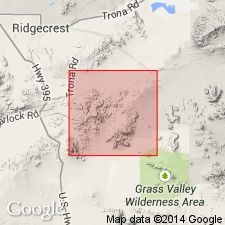
- Usage in publication:
-
- Lava Mountains Andesite*
- Modifications:
-
- Named
- Dominant lithology:
-
- Andesite
- AAPG geologic province:
-
- Mojave basin
Summary:
Named derived from Lava Mountains of which it forms an important part. Type locality designated on southeast side of Dome Mountain [NW/4 SW/4 sec.8 T29S R42E] Lava Mountains, San Bernardino Co, CA. Is approximately equivalent to Hulin's (1925) "Red Mountain Andesite". Consists of porphyritic plagioclase andesite. Occurs in tabular flows 200 to 600 ft thick, and as mounds and domes formed above areas of upwelling lava. Typically forms caps of rolling or flat-topped hills, cropping out to form soft or boulder-strewn areas on top and blocky cliffs along edges. Unconformably overlies Almond Mountain Volcanics (new) and older rocks (Bedrock Spring Formation, new). Overlain by few patches of gravel. Five Quaternary rock units are inferred to be younger on basis of indirect evidence. Probably very late Pliocene but may be in part Pleistocene age. Three lithologic units of Lava Mountains Andesite shown on geologic map of Lava Mountains.
Source: GNU records (USGS DDS-6; Menlo GNULEX).
For more information, please contact Nancy Stamm, Geologic Names Committee Secretary.
Asterisk (*) indicates published by U.S. Geological Survey authors.
"No current usage" (†) implies that a name has been abandoned or has fallen into disuse. Former usage and, if known, replacement name given in parentheses ( ).
Slash (/) indicates name conflicts with nomenclatural guidelines (CSN, 1933; ACSN, 1961, 1970; NACSN, 1983, 2005, 2021). May be explained within brackets ([ ]).

